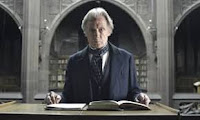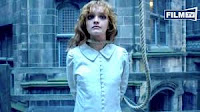 NOTE: This review contains some spoilers, but that shouldn't matter because the film offers its own spoilers early on.
NOTE: This review contains some spoilers, but that shouldn't matter because the film offers its own spoilers early on.
It's the East End of
London, before the Ripper murders, but the Limehouse Golem is a
serial killer who has already killed a prostitute, a Jewish scholar,
and a family in the rag trade. The police have no clue, but the
public and press are clamoring for results so Scotland Yard hands
the investigation to Inspector Kildare, a detective who has gone
nowhere in the Yard because he is 'not the marrying kind', and thus
will be gladly sacrificed to the public as the murders multiply.
But as Kildare joins
the case, he is presented with a domestic poisoning, of playwright
John Cree by his wife Lizzie, a former music hall star in the female
impersonator Dan Leno's shows. And the two cases turn out to be
connected, as Kildare discovers in the reading room of the British
Museum, where Thomas DeQuincey's infamous essay on the art of murder
has been annotated by the Golem himself. Which limits the list of
suspects to Cree, Leno, Karl Marx and George Gissing.
 Does this not sound
like the skeleton of a tremendous film? It is taken from Peter
Ackroyd's novel Dan Leno And The Limehouse Golem, and the
possibilities are endless. A conflation of the Ratcliff Highway
murders about which DeQuincey wrote, and the story of James Maybrick,
the Ripper suspect poisoned by his wife, Ackroyd's book was a rich
mining of the nuances of Victorian sexuality, as well as a turn about
performance, creation and fame. Screenwriter Jane Goldman said it was
a long-time dream of hers to adapt the book for the screen. But that
long-time does not appear to have been used in considering what would
be the best way to do that.
Does this not sound
like the skeleton of a tremendous film? It is taken from Peter
Ackroyd's novel Dan Leno And The Limehouse Golem, and the
possibilities are endless. A conflation of the Ratcliff Highway
murders about which DeQuincey wrote, and the story of James Maybrick,
the Ripper suspect poisoned by his wife, Ackroyd's book was a rich
mining of the nuances of Victorian sexuality, as well as a turn about
performance, creation and fame. Screenwriter Jane Goldman said it was
a long-time dream of hers to adapt the book for the screen. But that
long-time does not appear to have been used in considering what would
be the best way to do that.
The biggest problem
is that the story's big twist, the identity of the killer, is made
obvious a third of the way through the film, and that leaves the
viewer hoping that some more exotic twist may be in the offing—a
bit of stagecraft magic from Leno, perhaps, or a demented Kildare
turning out to be the killer. The latter would make great sense, not
just because Bill Nighy sleepwalks his way through the role, perhaps thinking he's already played a Peter Cushing role at least once. His eventual
awakening would be welcome, because Kildare's closeted
sexuality could have spurred exactly the sense of murderous rage the
killer shows. Though of course how it would apply to the victims
chosen would still be problematic. It's interesting that Alan Rickman was originally cast in the role, but had to bow out as he grew ill.
 Oddly enough, the
movie is content to leave most of those questions of sexuality
lurking in the background. Leno is a female impersonator; Lizzie
starts her career playing men. Kildare's assistant
turns out to be sympathetic to his sexuality, though nothing is made
of this. Uncle, the theatre manager played by Eddie Marsan, turns out
to be a sado-masochist not above blackmailing Lizzie into servicing
his needs. The acrobat Aveline (played with bitchy menace by Maria
Valverde), who loses Cree to Lizzie, then joins the household, taking
the pain of wifely duties away from Lizzie. This is a rich broth of
sexuality in conflict, but most of it goes nowhere. Perhaps they were worried about revealing the twist too son were they to reveal too much, but because they point you so obviously in the direction of the real killer that's no excuse.
Oddly enough, the
movie is content to leave most of those questions of sexuality
lurking in the background. Leno is a female impersonator; Lizzie
starts her career playing men. Kildare's assistant
turns out to be sympathetic to his sexuality, though nothing is made
of this. Uncle, the theatre manager played by Eddie Marsan, turns out
to be a sado-masochist not above blackmailing Lizzie into servicing
his needs. The acrobat Aveline (played with bitchy menace by Maria
Valverde), who loses Cree to Lizzie, then joins the household, taking
the pain of wifely duties away from Lizzie. This is a rich broth of
sexuality in conflict, but most of it goes nowhere. Perhaps they were worried about revealing the twist too son were they to reveal too much, but because they point you so obviously in the direction of the real killer that's no excuse.
The story is told
through imaginings by Kildare of the various suspects carrying out
the killings, and through Lizzie's own story, told to Kildare as she
awaits first trial and then the noose for poisoning her husband.
Kildare's protective attraction to Lizzie is hard to figure, except
that it's necessary for the plot, but we see Lizzie abused sexually
as a young girl and then punished brutally by her mother for having
been abused. Orphaned at 14, she makes her way into the theatre, and
with the unfortunate death of Leno's midget foil takes over that
place in his act and becomes a star.
 So as Lizzie directs
Kildare's Inspector Knacker, we lose further opportunities. Karl Marx
is played by Henry Goodman in a fake nose wig and beard as if he were
a music hall character, he adds nothing to the film; nor does Morgan
Watkins' George Gissing, though he is shown in an opium den and
explains he's married a fallen woman to try to save her.When you consider
the way director Juan Carlos Medina sets the scene, half Hammer
horror and half Ripper Street, to show us all the degradations of the
East End, you might expect to get more than a knowing nod to where
each of those characters came from.
So as Lizzie directs
Kildare's Inspector Knacker, we lose further opportunities. Karl Marx
is played by Henry Goodman in a fake nose wig and beard as if he were
a music hall character, he adds nothing to the film; nor does Morgan
Watkins' George Gissing, though he is shown in an opium den and
explains he's married a fallen woman to try to save her.When you consider
the way director Juan Carlos Medina sets the scene, half Hammer
horror and half Ripper Street, to show us all the degradations of the
East End, you might expect to get more than a knowing nod to where
each of those characters came from.
But in the end, it
is Lizzie's film, and Olivia Cooke rises to the challenge by
channeling her inner Kate Winslet, almost to the point of parody.
The directors' and her real interest seems to be the music hall and
the backstage world; obviously that is where Lizzie has come alive,
but it turns out to be a thing much deeper than that and we're never
really convinced of that.  And when the denouement comes, a lot of heavy mascara is no substitute for character. You might have expected a bit more of Dan
Leno, who is played well enough by Douglas Booth, though as with Marx
or Gissing, the film always backs off giving him more character to
explore. Even in the film's final scene, in which Aveline dies in an
accident, playing Lizzie in the noose, you wonder if there's
something you missed—though the film immediately tells you you
haven't, by going to a celebratory shot of Lizzie, though you
obviously have.
And when the denouement comes, a lot of heavy mascara is no substitute for character. You might have expected a bit more of Dan
Leno, who is played well enough by Douglas Booth, though as with Marx
or Gissing, the film always backs off giving him more character to
explore. Even in the film's final scene, in which Aveline dies in an
accident, playing Lizzie in the noose, you wonder if there's
something you missed—though the film immediately tells you you
haven't, by going to a celebratory shot of Lizzie, though you
obviously have.
 And when the denouement comes, a lot of heavy mascara is no substitute for character. You might have expected a bit more of Dan
Leno, who is played well enough by Douglas Booth, though as with Marx
or Gissing, the film always backs off giving him more character to
explore. Even in the film's final scene, in which Aveline dies in an
accident, playing Lizzie in the noose, you wonder if there's
something you missed—though the film immediately tells you you
haven't, by going to a celebratory shot of Lizzie, though you
obviously have.
And when the denouement comes, a lot of heavy mascara is no substitute for character. You might have expected a bit more of Dan
Leno, who is played well enough by Douglas Booth, though as with Marx
or Gissing, the film always backs off giving him more character to
explore. Even in the film's final scene, in which Aveline dies in an
accident, playing Lizzie in the noose, you wonder if there's
something you missed—though the film immediately tells you you
haven't, by going to a celebratory shot of Lizzie, though you
obviously have.
It's that kind of
movie. Gratuitously violent at times, well-set up at others, it in
the end goes around in circles, to no point because the audience
knows too well where it is going to end up. It would have been easy
to have made the journey more worthwhile.

No comments :
Post a Comment